Business Ethics Case Study: Pester Power and Advertising Practices
VerifiedAdded on 2022/09/17
|6
|1331
|31
Case Study
AI Summary
This case study delves into the ethical implications of pester power and misleading advertising, using a scenario where a child desires a popular toy due to peer pressure fueled by aggressive marketing. The paper examines the detrimental aspects of pester power, the relevant legislation enforced by the Australian Competition and Consumer Commission (ACCC) regarding misleading advertising, and the voluntary codes established by the Australian Association of National Advertisers (AANA). It explores the ethical dimensions of misleading advertising, particularly for children and vulnerable groups, through the lens of ethical theories such as virtue ethics, consequentialism, and non-consequentialism. The study highlights the importance of ethical considerations in marketing practices and the potential negative impacts of unethical advertising on consumers and the reputation of businesses. The conclusion emphasizes the need for ethical awareness among advertisers, parents, and civic bodies to mitigate the harmful effects of pestering advertisements.
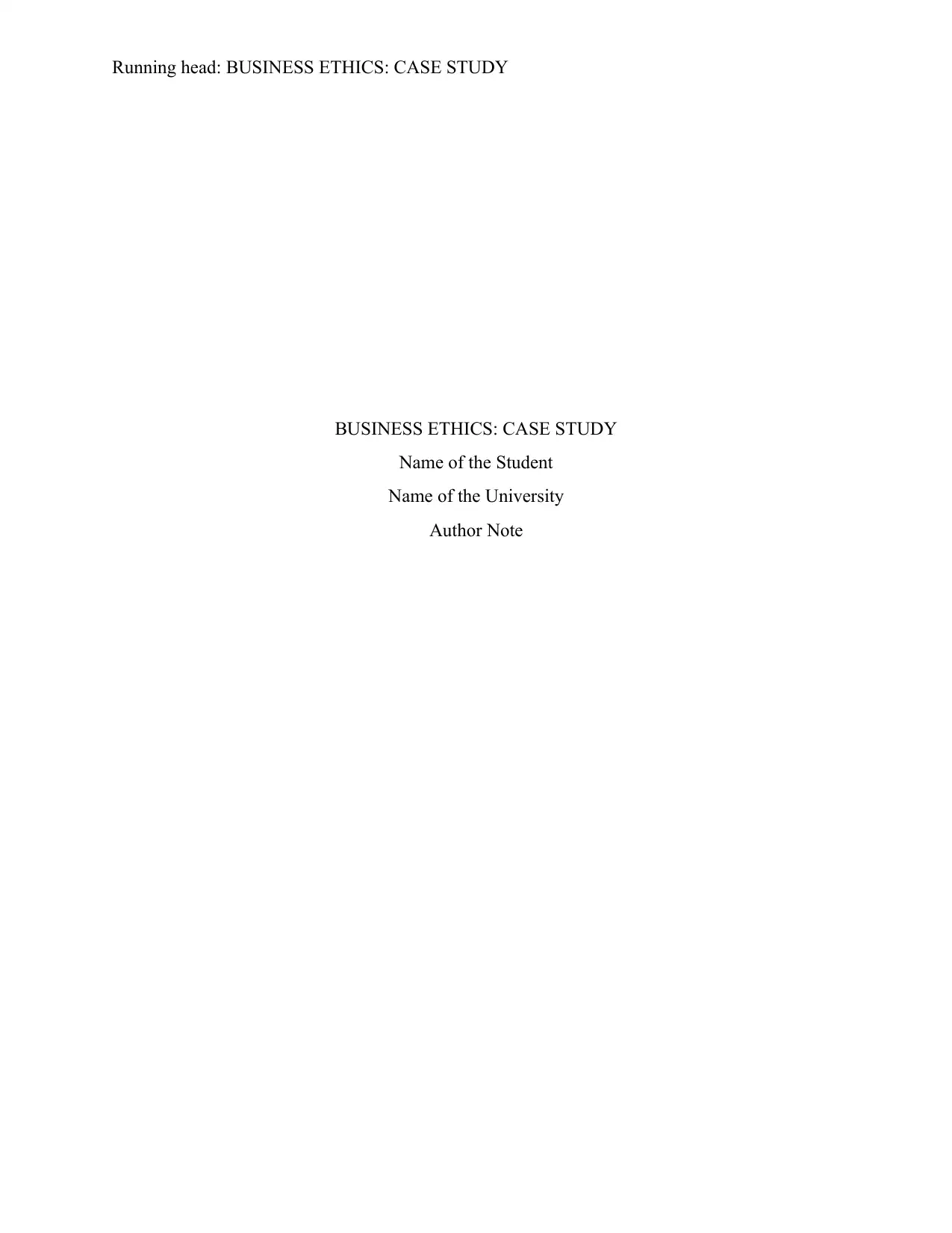
Running head: BUSINESS ETHICS: CASE STUDY
BUSINESS ETHICS: CASE STUDY
Name of the Student
Name of the University
Author Note
BUSINESS ETHICS: CASE STUDY
Name of the Student
Name of the University
Author Note
Paraphrase This Document
Need a fresh take? Get an instant paraphrase of this document with our AI Paraphraser
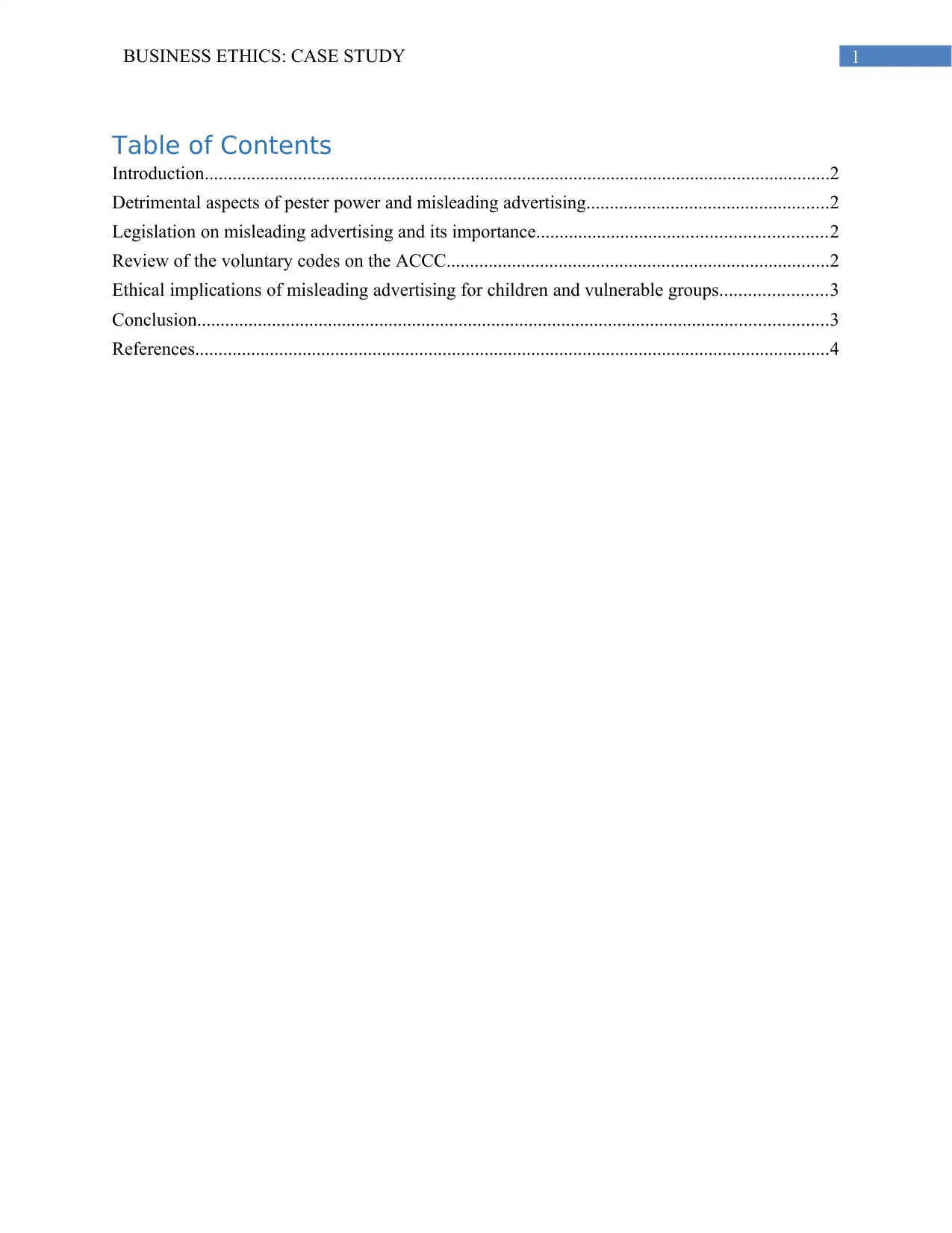
1BUSINESS ETHICS: CASE STUDY
Table of Contents
Introduction......................................................................................................................................2
Detrimental aspects of pester power and misleading advertising....................................................2
Legislation on misleading advertising and its importance..............................................................2
Review of the voluntary codes on the ACCC..................................................................................2
Ethical implications of misleading advertising for children and vulnerable groups.......................3
Conclusion.......................................................................................................................................3
References........................................................................................................................................4
Table of Contents
Introduction......................................................................................................................................2
Detrimental aspects of pester power and misleading advertising....................................................2
Legislation on misleading advertising and its importance..............................................................2
Review of the voluntary codes on the ACCC..................................................................................2
Ethical implications of misleading advertising for children and vulnerable groups.......................3
Conclusion.......................................................................................................................................3
References........................................................................................................................................4
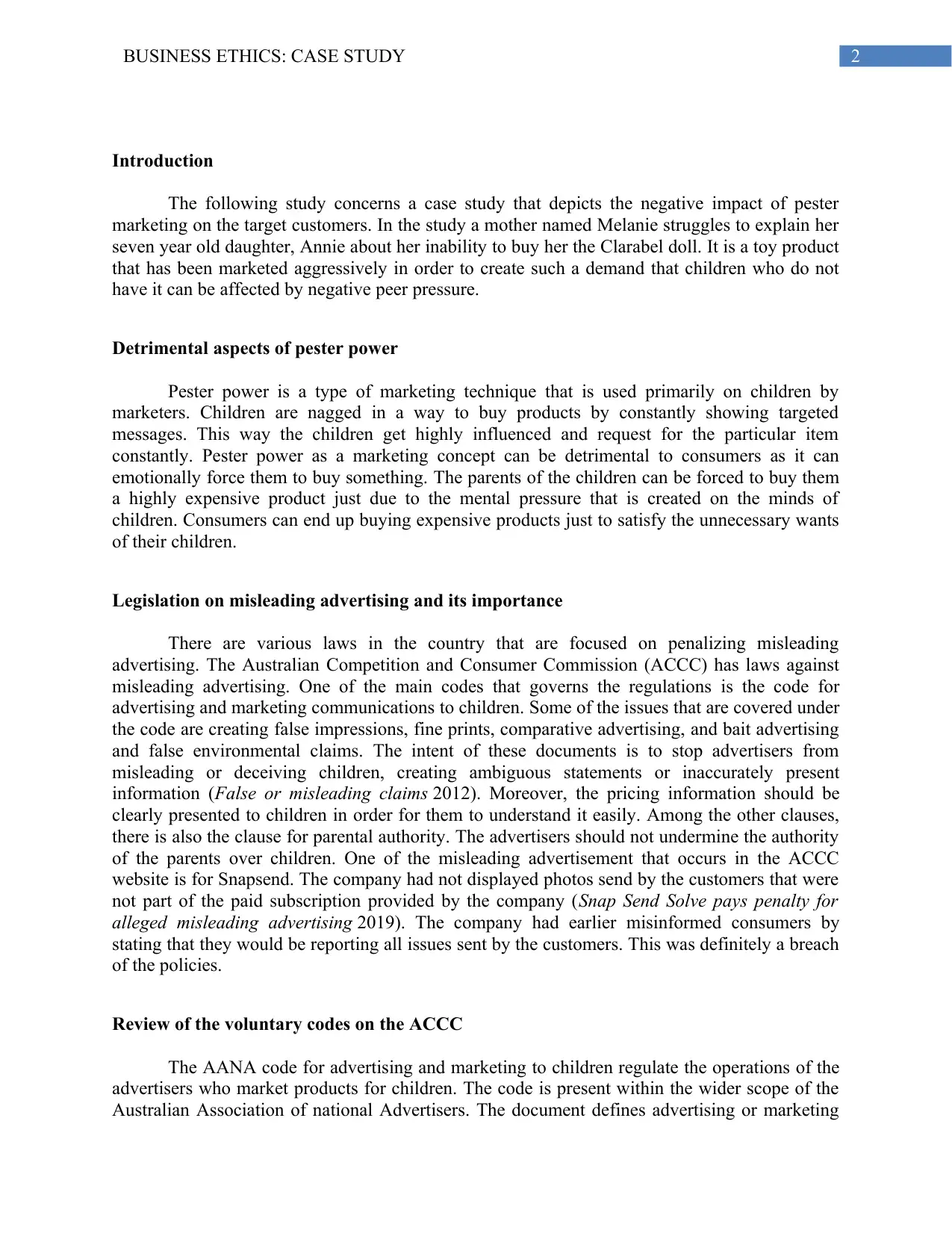
2BUSINESS ETHICS: CASE STUDY
Introduction
The following study concerns a case study that depicts the negative impact of pester
marketing on the target customers. In the study a mother named Melanie struggles to explain her
seven year old daughter, Annie about her inability to buy her the Clarabel doll. It is a toy product
that has been marketed aggressively in order to create such a demand that children who do not
have it can be affected by negative peer pressure.
Detrimental aspects of pester power
Pester power is a type of marketing technique that is used primarily on children by
marketers. Children are nagged in a way to buy products by constantly showing targeted
messages. This way the children get highly influenced and request for the particular item
constantly. Pester power as a marketing concept can be detrimental to consumers as it can
emotionally force them to buy something. The parents of the children can be forced to buy them
a highly expensive product just due to the mental pressure that is created on the minds of
children. Consumers can end up buying expensive products just to satisfy the unnecessary wants
of their children.
Legislation on misleading advertising and its importance
There are various laws in the country that are focused on penalizing misleading
advertising. The Australian Competition and Consumer Commission (ACCC) has laws against
misleading advertising. One of the main codes that governs the regulations is the code for
advertising and marketing communications to children. Some of the issues that are covered under
the code are creating false impressions, fine prints, comparative advertising, and bait advertising
and false environmental claims. The intent of these documents is to stop advertisers from
misleading or deceiving children, creating ambiguous statements or inaccurately present
information (False or misleading claims 2012). Moreover, the pricing information should be
clearly presented to children in order for them to understand it easily. Among the other clauses,
there is also the clause for parental authority. The advertisers should not undermine the authority
of the parents over children. One of the misleading advertisement that occurs in the ACCC
website is for Snapsend. The company had not displayed photos send by the customers that were
not part of the paid subscription provided by the company (Snap Send Solve pays penalty for
alleged misleading advertising 2019). The company had earlier misinformed consumers by
stating that they would be reporting all issues sent by the customers. This was definitely a breach
of the policies.
Review of the voluntary codes on the ACCC
The AANA code for advertising and marketing to children regulate the operations of the
advertisers who market products for children. The code is present within the wider scope of the
Australian Association of national Advertisers. The document defines advertising or marketing
Introduction
The following study concerns a case study that depicts the negative impact of pester
marketing on the target customers. In the study a mother named Melanie struggles to explain her
seven year old daughter, Annie about her inability to buy her the Clarabel doll. It is a toy product
that has been marketed aggressively in order to create such a demand that children who do not
have it can be affected by negative peer pressure.
Detrimental aspects of pester power
Pester power is a type of marketing technique that is used primarily on children by
marketers. Children are nagged in a way to buy products by constantly showing targeted
messages. This way the children get highly influenced and request for the particular item
constantly. Pester power as a marketing concept can be detrimental to consumers as it can
emotionally force them to buy something. The parents of the children can be forced to buy them
a highly expensive product just due to the mental pressure that is created on the minds of
children. Consumers can end up buying expensive products just to satisfy the unnecessary wants
of their children.
Legislation on misleading advertising and its importance
There are various laws in the country that are focused on penalizing misleading
advertising. The Australian Competition and Consumer Commission (ACCC) has laws against
misleading advertising. One of the main codes that governs the regulations is the code for
advertising and marketing communications to children. Some of the issues that are covered under
the code are creating false impressions, fine prints, comparative advertising, and bait advertising
and false environmental claims. The intent of these documents is to stop advertisers from
misleading or deceiving children, creating ambiguous statements or inaccurately present
information (False or misleading claims 2012). Moreover, the pricing information should be
clearly presented to children in order for them to understand it easily. Among the other clauses,
there is also the clause for parental authority. The advertisers should not undermine the authority
of the parents over children. One of the misleading advertisement that occurs in the ACCC
website is for Snapsend. The company had not displayed photos send by the customers that were
not part of the paid subscription provided by the company (Snap Send Solve pays penalty for
alleged misleading advertising 2019). The company had earlier misinformed consumers by
stating that they would be reporting all issues sent by the customers. This was definitely a breach
of the policies.
Review of the voluntary codes on the ACCC
The AANA code for advertising and marketing to children regulate the operations of the
advertisers who market products for children. The code is present within the wider scope of the
Australian Association of national Advertisers. The document defines advertising or marketing
⊘ This is a preview!⊘
Do you want full access?
Subscribe today to unlock all pages.

Trusted by 1+ million students worldwide
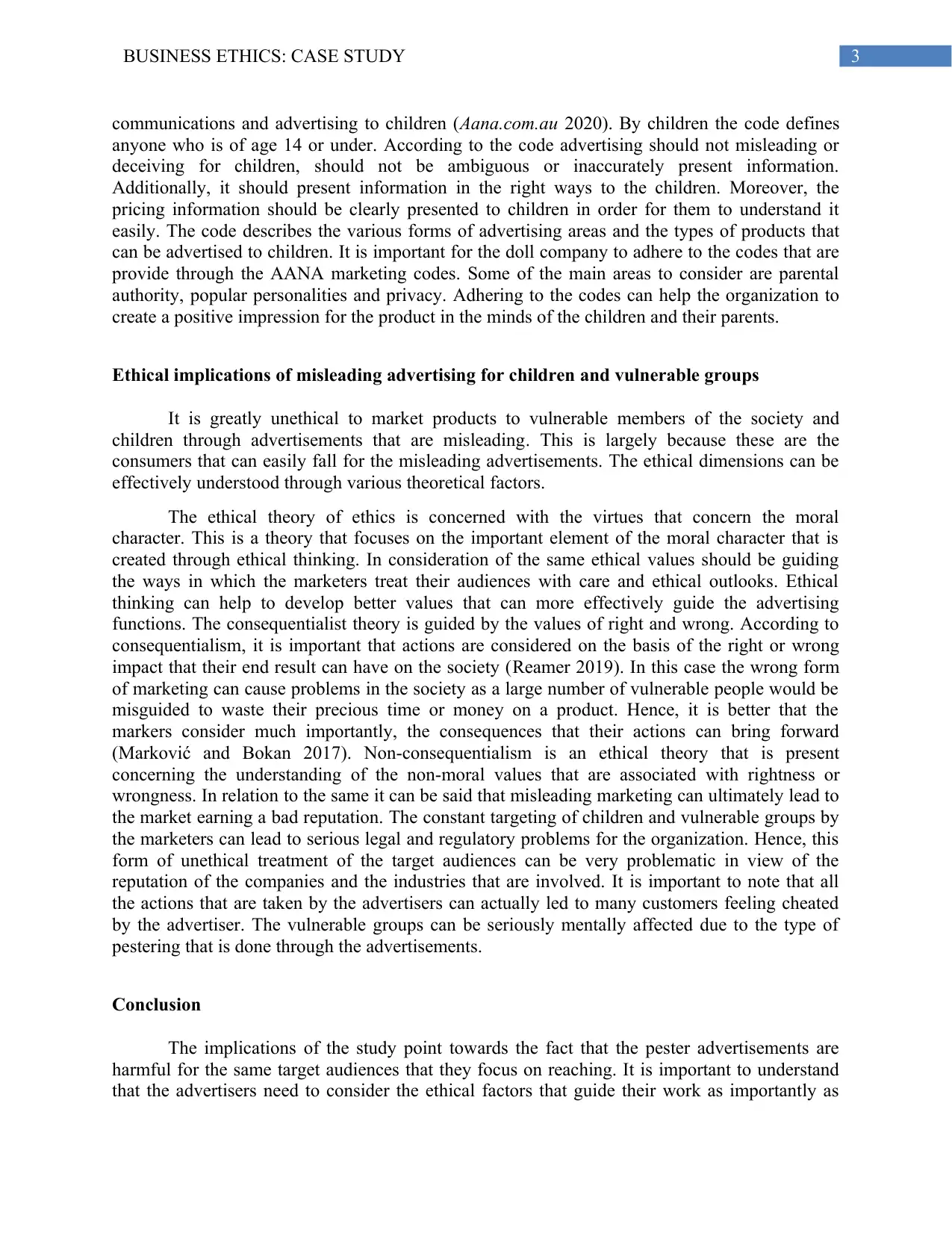
3BUSINESS ETHICS: CASE STUDY
communications and advertising to children (Aana.com.au 2020). By children the code defines
anyone who is of age 14 or under. According to the code advertising should not misleading or
deceiving for children, should not be ambiguous or inaccurately present information.
Additionally, it should present information in the right ways to the children. Moreover, the
pricing information should be clearly presented to children in order for them to understand it
easily. The code describes the various forms of advertising areas and the types of products that
can be advertised to children. It is important for the doll company to adhere to the codes that are
provide through the AANA marketing codes. Some of the main areas to consider are parental
authority, popular personalities and privacy. Adhering to the codes can help the organization to
create a positive impression for the product in the minds of the children and their parents.
Ethical implications of misleading advertising for children and vulnerable groups
It is greatly unethical to market products to vulnerable members of the society and
children through advertisements that are misleading. This is largely because these are the
consumers that can easily fall for the misleading advertisements. The ethical dimensions can be
effectively understood through various theoretical factors.
The ethical theory of ethics is concerned with the virtues that concern the moral
character. This is a theory that focuses on the important element of the moral character that is
created through ethical thinking. In consideration of the same ethical values should be guiding
the ways in which the marketers treat their audiences with care and ethical outlooks. Ethical
thinking can help to develop better values that can more effectively guide the advertising
functions. The consequentialist theory is guided by the values of right and wrong. According to
consequentialism, it is important that actions are considered on the basis of the right or wrong
impact that their end result can have on the society (Reamer 2019). In this case the wrong form
of marketing can cause problems in the society as a large number of vulnerable people would be
misguided to waste their precious time or money on a product. Hence, it is better that the
markers consider much importantly, the consequences that their actions can bring forward
(Marković and Bokan 2017). Non-consequentialism is an ethical theory that is present
concerning the understanding of the non-moral values that are associated with rightness or
wrongness. In relation to the same it can be said that misleading marketing can ultimately lead to
the market earning a bad reputation. The constant targeting of children and vulnerable groups by
the marketers can lead to serious legal and regulatory problems for the organization. Hence, this
form of unethical treatment of the target audiences can be very problematic in view of the
reputation of the companies and the industries that are involved. It is important to note that all
the actions that are taken by the advertisers can actually led to many customers feeling cheated
by the advertiser. The vulnerable groups can be seriously mentally affected due to the type of
pestering that is done through the advertisements.
Conclusion
The implications of the study point towards the fact that the pester advertisements are
harmful for the same target audiences that they focus on reaching. It is important to understand
that the advertisers need to consider the ethical factors that guide their work as importantly as
communications and advertising to children (Aana.com.au 2020). By children the code defines
anyone who is of age 14 or under. According to the code advertising should not misleading or
deceiving for children, should not be ambiguous or inaccurately present information.
Additionally, it should present information in the right ways to the children. Moreover, the
pricing information should be clearly presented to children in order for them to understand it
easily. The code describes the various forms of advertising areas and the types of products that
can be advertised to children. It is important for the doll company to adhere to the codes that are
provide through the AANA marketing codes. Some of the main areas to consider are parental
authority, popular personalities and privacy. Adhering to the codes can help the organization to
create a positive impression for the product in the minds of the children and their parents.
Ethical implications of misleading advertising for children and vulnerable groups
It is greatly unethical to market products to vulnerable members of the society and
children through advertisements that are misleading. This is largely because these are the
consumers that can easily fall for the misleading advertisements. The ethical dimensions can be
effectively understood through various theoretical factors.
The ethical theory of ethics is concerned with the virtues that concern the moral
character. This is a theory that focuses on the important element of the moral character that is
created through ethical thinking. In consideration of the same ethical values should be guiding
the ways in which the marketers treat their audiences with care and ethical outlooks. Ethical
thinking can help to develop better values that can more effectively guide the advertising
functions. The consequentialist theory is guided by the values of right and wrong. According to
consequentialism, it is important that actions are considered on the basis of the right or wrong
impact that their end result can have on the society (Reamer 2019). In this case the wrong form
of marketing can cause problems in the society as a large number of vulnerable people would be
misguided to waste their precious time or money on a product. Hence, it is better that the
markers consider much importantly, the consequences that their actions can bring forward
(Marković and Bokan 2017). Non-consequentialism is an ethical theory that is present
concerning the understanding of the non-moral values that are associated with rightness or
wrongness. In relation to the same it can be said that misleading marketing can ultimately lead to
the market earning a bad reputation. The constant targeting of children and vulnerable groups by
the marketers can lead to serious legal and regulatory problems for the organization. Hence, this
form of unethical treatment of the target audiences can be very problematic in view of the
reputation of the companies and the industries that are involved. It is important to note that all
the actions that are taken by the advertisers can actually led to many customers feeling cheated
by the advertiser. The vulnerable groups can be seriously mentally affected due to the type of
pestering that is done through the advertisements.
Conclusion
The implications of the study point towards the fact that the pester advertisements are
harmful for the same target audiences that they focus on reaching. It is important to understand
that the advertisers need to consider the ethical factors that guide their work as importantly as
Paraphrase This Document
Need a fresh take? Get an instant paraphrase of this document with our AI Paraphraser
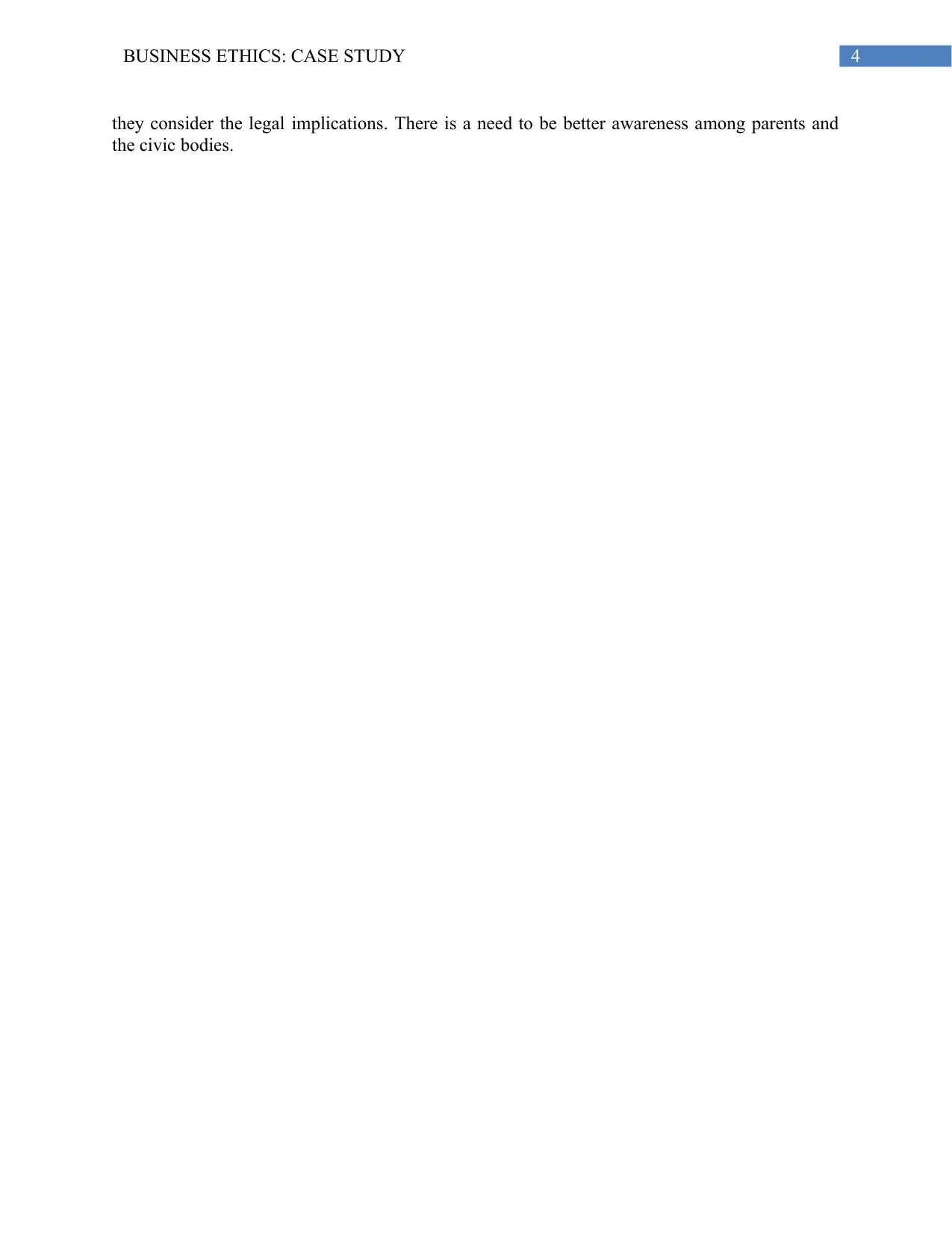
4BUSINESS ETHICS: CASE STUDY
they consider the legal implications. There is a need to be better awareness among parents and
the civic bodies.
they consider the legal implications. There is a need to be better awareness among parents and
the civic bodies.
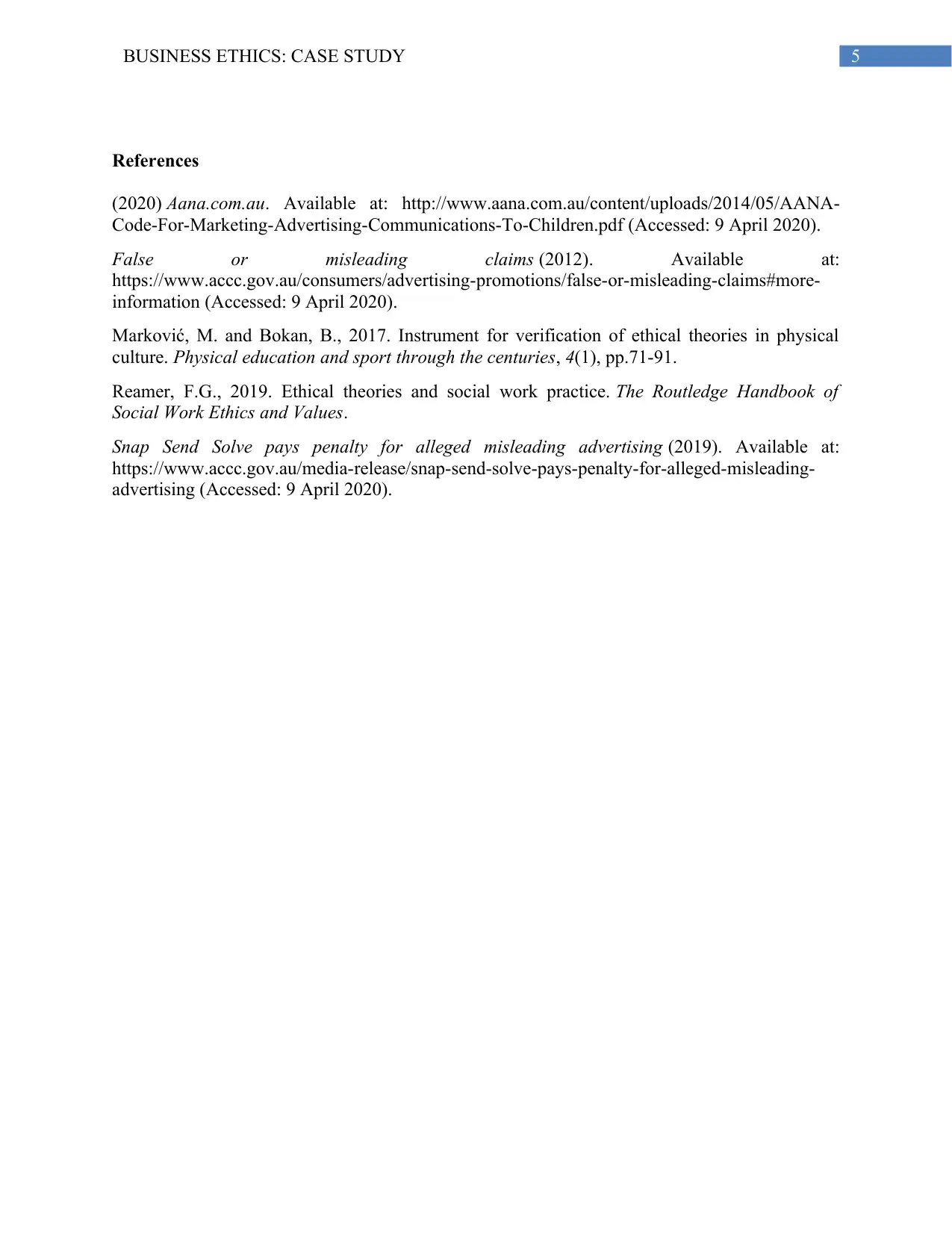
5BUSINESS ETHICS: CASE STUDY
References
(2020) Aana.com.au. Available at: http://www.aana.com.au/content/uploads/2014/05/AANA-
Code-For-Marketing-Advertising-Communications-To-Children.pdf (Accessed: 9 April 2020).
False or misleading claims (2012). Available at:
https://www.accc.gov.au/consumers/advertising-promotions/false-or-misleading-claims#more-
information (Accessed: 9 April 2020).
Marković, M. and Bokan, B., 2017. Instrument for verification of ethical theories in physical
culture. Physical education and sport through the centuries, 4(1), pp.71-91.
Reamer, F.G., 2019. Ethical theories and social work practice. The Routledge Handbook of
Social Work Ethics and Values.
Snap Send Solve pays penalty for alleged misleading advertising (2019). Available at:
https://www.accc.gov.au/media-release/snap-send-solve-pays-penalty-for-alleged-misleading-
advertising (Accessed: 9 April 2020).
References
(2020) Aana.com.au. Available at: http://www.aana.com.au/content/uploads/2014/05/AANA-
Code-For-Marketing-Advertising-Communications-To-Children.pdf (Accessed: 9 April 2020).
False or misleading claims (2012). Available at:
https://www.accc.gov.au/consumers/advertising-promotions/false-or-misleading-claims#more-
information (Accessed: 9 April 2020).
Marković, M. and Bokan, B., 2017. Instrument for verification of ethical theories in physical
culture. Physical education and sport through the centuries, 4(1), pp.71-91.
Reamer, F.G., 2019. Ethical theories and social work practice. The Routledge Handbook of
Social Work Ethics and Values.
Snap Send Solve pays penalty for alleged misleading advertising (2019). Available at:
https://www.accc.gov.au/media-release/snap-send-solve-pays-penalty-for-alleged-misleading-
advertising (Accessed: 9 April 2020).
⊘ This is a preview!⊘
Do you want full access?
Subscribe today to unlock all pages.

Trusted by 1+ million students worldwide
1 out of 6
Related Documents
Your All-in-One AI-Powered Toolkit for Academic Success.
+13062052269
info@desklib.com
Available 24*7 on WhatsApp / Email
![[object Object]](/_next/static/media/star-bottom.7253800d.svg)
Unlock your academic potential
Copyright © 2020–2025 A2Z Services. All Rights Reserved. Developed and managed by ZUCOL.



